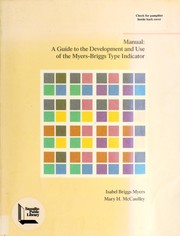Check nearby libraries
Buy this book

From the Introduction...
The purpose of the Myers-Briggs Type Indicator15 (MBTI®) is to make the theory of psychological types described by C. G. Jung (1921/1971) understandable and useful in people's lives. The essence of the theory is that much seemingly random variation in behavior is actually quite orderly and consistent, being due to basic differences in the way individuals prefer to use their perception and judgment.
Check nearby libraries
Buy this book

Previews available in: English
Showing 1 featured edition. View all 1 editions?
| Edition | Availability |
|---|---|
|
1
Manual, a guide to the development and use of the Myers-Briggs type indicator
1985, Consulting Psychologists Press
in English
0891060278 9780891060277
|
aaaa
Libraries near you:
WorldCat
|
Book Details
Table of Contents
Examples of Counseling Issues for Each Preference
Ranking of occupations by preference for.
Edition Notes
Bibliography: p. 296-309.
Classifications
Contributors
The Physical Object
ID Numbers
Community Reviews (0)
Feedback?History
- Created April 1, 2008
- 15 revisions
Wikipedia citation
×CloseCopy and paste this code into your Wikipedia page. Need help?
| July 25, 2024 | Edited by MARC Bot | import existing book |
| August 27, 2023 | Edited by 21-036 Putri Anggraini Sinulingga | Update covers |
| March 17, 2021 | Edited by ImportBot | import existing book |
| March 3, 2021 | Edited by MARC Bot | import existing book |
| April 1, 2008 | Created by an anonymous user | Imported from Scriblio MARC record |













